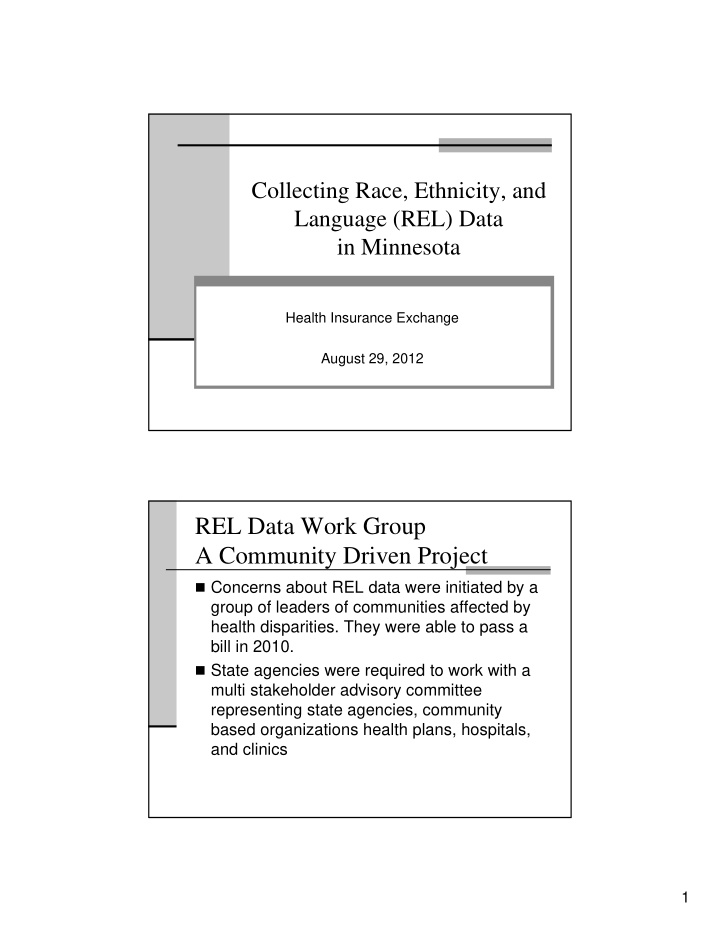



Collecting Race, Ethnicity, and Language (REL) Data in Minnesota Health Insurance Exchange August 29, 2012 REL Data Work Group A Community Driven Project Concerns about REL data were initiated by a group of leaders of communities affected by health disparities. They were able to pass a bill in 2010. State agencies were required to work with a multi stakeholder advisory committee representing state agencies, community based organizations health plans, hospitals, and clinics 1
Community REL Data Partnership Hospitals Community-Based Organizations Medical Association ARCHé Health Plans Immigrants of Color Clinics African American MN Community American Indian Measurement Latino/Hispanic Academia Asian Co-Chairs MDH , DHS Purpose To establish a common framework for standardized REL data collection, for the purpose of identifying and reducing health disparities, and improving health, in the state of Minnesota 2
REL Data Collection Principles Data should be self-reported by the data subject. Select more than one race/ethnicity category. Include categories that are relevant to MN populations. Aggregate race/ethnicity categories into existing OMB race/ethnicity categories. REL category review, by a public/private collaborative to ensure relevance to changing Minnesota demographics. Health care providers or health care program staff appropriately trained on how to collect REL data in an accurate and respectful manner. MN Health Care Reform Recommendations Standardized data collection Implementation throughout the health care system, health reform efforts Community REL partnership continuing work Data sharing, reporting and dissemination Additional variables representing factors that influence health (e.g. socioeconomic status) 3
OMB standard (Race/Ethnicity) OMB categories, plus additional options Hispanic Ethnicity Race Select one or more races follow-up question to indicate race respondent most identifies with Granular Ethnicity Granular Ethnicity & Tribal Affiliation Based on locally relevant choices Country of Birth Based on locally relevant choices “Granular Ethnicity” is defined as “a person's ethnic origin or descent, 'roots,' or heritage, or the place of birth of the person or the person's parents or ancestors...” This includes American Indian tribal affiliation. IOM (Institute of Medicine). 2009. Race, Ethnicity, and Language Data: Standardization for Health Care Quality Improvement. Washington, DC: The National Academies Press. 4
Language Spoken and/or written language preferred for health care Based on locally relevant choices Inclusion of sign language as spoken language option Inclusion of Braille as written language option A Work in Progress We recognize that the categories chosen are not an exhaustive list, but are a practical starting point for collecting data by Race, Ethnicity and Language in Minnesota. We look forward to using this collection platform as a basis for expanding / changing the categories, based upon the experience of the data collection process that occurs in the health care system, and the changing demographics of populations in Minnesota. 5
Contact Information David Stroud Center for Health Statistics Minnesota Department of Health 651-201-5954 david.stroud@state.mn.us Ginny Zawistowski Performance Measurement and Quality Improvement Minnesota Department of Human Services 651-431-2614 virginia.zawistowski@state.mn.us 6
Recommend
More recommend